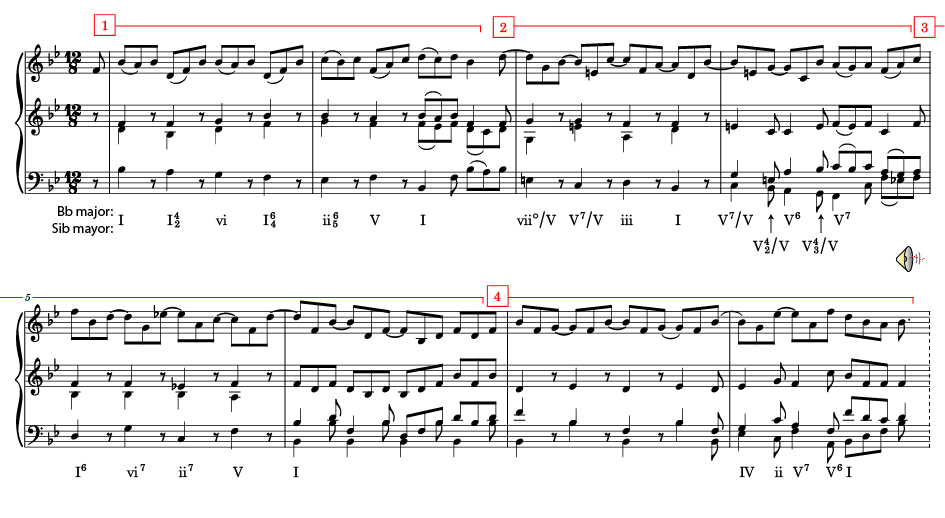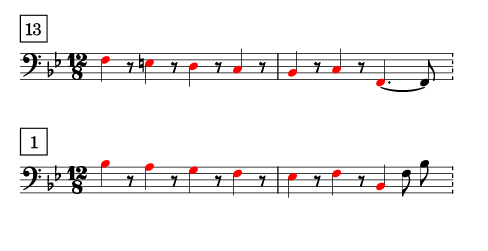Bach - Brandenburg Concerto No. 6 BWV 1051 - III. Allegro.
José Rodríguez Alvira
This is the formal structure of the movement. The A section - in B flat major - plays the role of ritornello. Its four appearances alternate with the B and C developmental sections:

First ritornello, measures 1 to 8. Bb major.
- Four two-bar phrases form the A section or ritornello.
- Both the thematic material of the upper voice as well as the bass and the harmonic plan will be re-used in the developments.

- The main melody is played in unison by the violas da braccio.
- It is accompanied by the viola da gamba, cello and violone.
Douglas Boyd (conductor), Gardner Chamber Orchestra (ensemble)
Creative Commons Attribution Non-commercial No Derivatives 3.0

First development, measures 9 to 37.
We will divide this section for discussion.
Measures 9 to 12
These bars are based on the harmonic plan of the first four bars. Below, we compare the bass of bars 9 to 12 with the bass of bars 1 to 4. We can see that it is a variation of the original bass:

Measures 9 to 12
The two violas dialogue over the bass played by the cello. From bar 10, the first viola takes over the syncopated motives of the theme, while the second viola follows with sixteenth notes:
Douglas Boyd (conductor), Gardner Chamber Orchestra (ensemble)
Creative Commons Attribution Non-commercial No Derivatives 3.0
Measures 13 to 14
Transposed to F major, the cello takes up the bass of the first two bars:

Measures 15 to 22
From bar 15, Bach varies the bass from bars 1 to 8 in the key of F major (we only show the first four bars):

Measures 13 to 22
F anc C major keys (measures 17 and 18).
| Measures | |
| 13 to 14 | The cello is based on the bass line of bars 1 and 2. |
| The theme is repeated in unison by the violas. | |
| 15 to 22 | Variation of the bass from bar 1 to 8. |
| The violas dialogue with sixteenth notes, sometimes taking the theme's syncopated part. |
Douglas Boyd (conductor), Gardner Chamber Orchestra (ensemble)
Creative Commons Attribution Non-commercial No Derivatives 3.0
Measures 23 to 31
- We return to Bb major, but the chromaticism increases.
- The cello develops the first notes of the bass of the second phrase using sixteenth notes. It uses the bass of phrase 3 from bar 27.
- The violas da braccio dialogue with longer notes.
- The viola da gamba and the violone reinforce the passage.
Douglas Boyd (conductor), Gardner Chamber Orchestra (ensemble)
Creative Commons Attribution Non-commercial No Derivatives 3.0
Measures 32 to 37
- These bars follow the harmonic plan of phrases 1, 3 and 4.
- The key of Bb major is confirmed.
Douglas Boyd (conductor), Gardner Chamber Orchestra (ensemble)
Creative Commons Attribution Non-commercial No Derivatives 3.0

Second ritornello, measures 37 to 45.
The second ritornello is an exact repetition of the first:
Douglas Boyd (conductor), Gardner Chamber Orchestra (ensemble)
Creative Commons Attribution Non-commercial No Derivatives 3.0

Second development, measures 45 to 65.
In the second development, the main keys are G and D minor, although we visit the keys of C minor and F major. Again, the bass uses the theme as a harmonic base.
We begin with the octaves of the third phrase in G minor.
Second phrase
First phrase
The key of D minor is asserted over the octaves of the third phrase
Third phrase
Fourth phrase
Douglas Boyd (conductor), Gardner Chamber Orchestra (ensemble)
Creative Commons Attribution Non-commercial No Derivatives 3.0

The third ritornello, measures 66 to 73.
The third ritornello is an exact repetition of the first:

Third development, measures 73 to 102.
The third development is an exact repetition of bars 9 to 37.

Last ritornello, measures 102 to 110.
The last ritornello is an exact repetition of the previous ritornellos.
Douglas Boyd (conductor), Gardner Chamber Orchestra (ensemble)
Creative Commons Attribution Non-commercial No Derivatives 3.0

This work is licensed under a Creative Commons Attribution-NonCommercial-NoDerivatives 4.0 International License. José Rodríguez Alvira.
Published by teoria.com